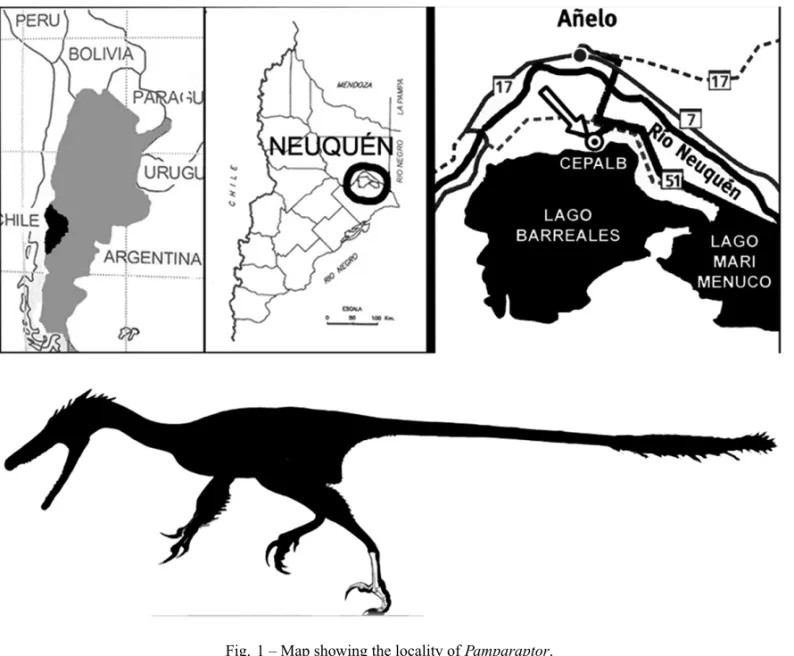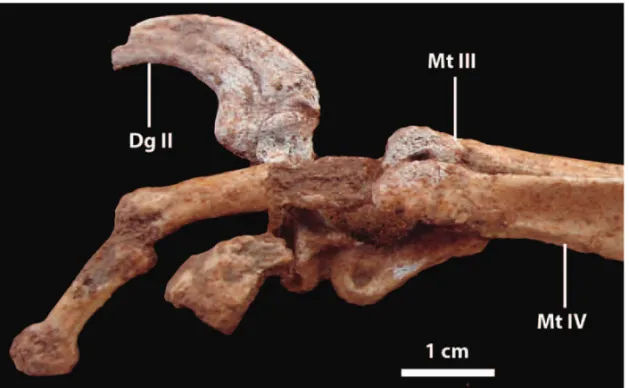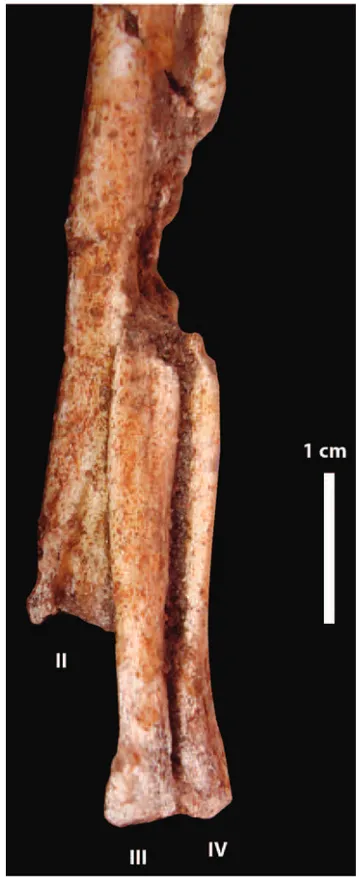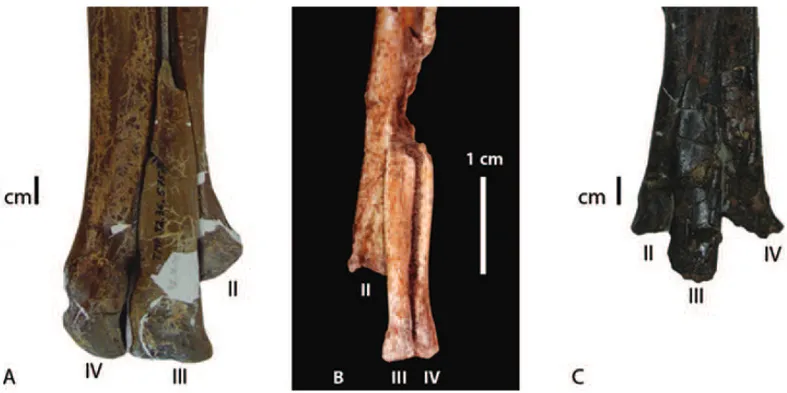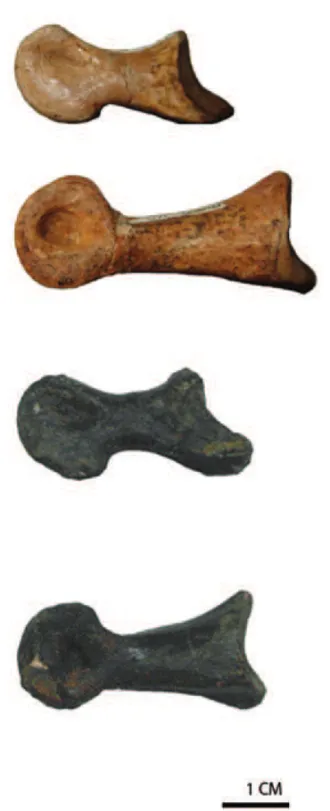Here we report on a new small deinonychosaurian theropod,Pamparaptor microsgen. et sp. nov., from the Late
Cre-taceous of Patagonia, Argentina.Pamparaptor microsexhibits a pedal structure previously unknown among South American deinonychosaurians. The new material provides new evidence about the morphology and taxonomic di-versity of Patagonian deinonychosaurs.Pamparaptoris the smaller non-avialae Patagonian deinonychosaur, probably
with about 0.50-0.70 meters, long. The pedal construction resembles, that of Troodontid or basal Dromaeosaurids. Nevertheless, up to now, we consideredPamparaptora peculiar Patagonian Dromaeosaurid with troodontid-like pes.
Key words:Argentina, Barreales Lake, Dromaeosauridae, Late Cretaceous, Patagonia, Unenlagiinae.
INTRODUCTION
During the last decade, the fossil record of deinony-chosaurian theropods from Patagonia has notably in-creased. Up to now, the records of Deinonychosauria from Patagonia include Unenlagia comahuensis
(No-vas and Puerta 1997), Unenlagia paynemili (Calvo et
al. 2004), Neuquenraptor argentinus (Novas and Pol
2005), Buitreraptor gonzalezorum (Makovicky et al.
2005) and Austroraptor cabazai (Novas et al. 2008). Here we report on a new deinonychosaurian, Pampa-raptor micros gen. nov sp. nov, collected from the Baal quarry, at the north coast of Barreales Lake, Neu-quén, Argentina (Fig. 1). The specimen comes from the Portezuelo Formation, (Turonian-Coniacian), Neuquén Group, and it is represented by pedal elements. The new form is gracile and small, with about 0.50-0.70 meters, and its metatarsal construction is highly derived, resem-bling troodontids (Xu and Wang 2000). We offer here a brief description of this notable discovery.
Proceedings of the Third Gondwanan Dinosaur Symposium Correspondence to: Juan D. Porfiri
E-mail: jporfiri@yahoo.com
SYSTEMATIC PALEONTOLOGY
SAURISCHIASeeley, 1887 THEROPODAMarsh, 1881
DEINONYCHOSAURIAColbert and Russell, 1969
Pamparaptor microsnew taxon
Etymology:Pampa, in honor to the Indian Pampas that
lived in the central plain of Argentina; andraptor, robber
in Greek;micros, for the small size of specimen.
Holotype: The holotype MUCPv-1163 (Figs. 2-3) is
represented by an articulated left foot including well-preserved metatarsals II, III and IV, complete digit II, phalanges III-1, III-2 (well-preserved), and incomplete phalanges IV-2 and IV-3. The specimen was found in 2005 by Mr. Diego Rosales who is the technician of the Centro Paleontológico Lago Barreales (CePaLB), Universidad Nacional del Comahue.
Horizon, age and locality: The Portezuelo Formation,
Fig. 1 – Map showing the locality ofPamparaptor.
Fig. 3 – Proximal end of metatarsals in anterior view.
of Barreales Lake, at 90 kilometers NW of Neuquén city, Neuquén province, Patagonia, Argentina. Up to now, the record of dinosaurs collected in the Portezuelo Formation includes the giant lognkosaurian titanosaur
Futalognkosaurus dukei (Calvo et al. 2007), the
dro-maeosauridsUnenlagia comahuensis(Novas and Puerta
1997), Unenlagia paynemili (Calvo et al. 2004), and Neuquenraptor argentinus(Novas and Pol 2005), the
al-varezsauridPatagonykus puertai (Novas 1997), the
al-losauroidMegaraptor namuhnuaiquii(Novas 1998), as
well as abelisaurids remains (Novas et al. 2006, Juárez Valieri et al. 2008), undescribed theropods (Porfiri et al. 2005), and fragmentary remains of a possible neor-nithine bird (Agnolín et al. 2006).
Diagnosis: Pamparaptor micros distinguishes from
other deinonychosaurians in the following combination
of features: slender metatarsus construction with meta-tarsals IV strongly compressed transversely on its dis-tal half, acquiring a blade-like shape in caudal view; metatarsals IV and III subequal in length; proximal half of metatarsal III narrow and with subparalel margins along its length; metatarsal III lacking a distal gingly-mus; metatarsal II distally overlapping metatarsal III; proximally, metatarsal II is approximately twice the wide of either metatarsals III and IV; phalanx 2.II longer than phalanx 2.I; in cranial view, distal end of metatarsal II with a small sulcus medially directed.
Description and comparison: The articulated left
Fig. 4 – Distal end of metatarsals, phalanges and claw in lateral view.
The first and fifth metatarsals are absent. Metatar-sal II is shorter than metatarMetatar-sals III and IV. The sec-ond metatarsal is less compressed mediolaterally than metatarsals III and IV. Metatarsal II is 3.5 mm thick for most of its 82.1 mm length. The distal articular surface of metatarsal II present a well-developed gyn-glimus, which is different to the troodontids Sauror-nithoides mongoliensis (IVPP V 10597), Tochisaurus nemegtensis (after Kurzanov 1987) and Troodon for-mosus (after Wilson and Currie 1985). The troodontid Borogovia gracilicrus (alter Olsmolska 1987) presents
a poorly-developed gynglimus, which is less-developed than inPamparaptor. The third and fourth metatarsals
are the longest elements in the metatarsus. The third metatarsal expend for all front of metatarsus and is not squeezed out by the second and fourth metatarsals throughout most of the midshaft region as in the troo-dontids Troodon(Wilson and Currie 1985) and Tochi-saurus(Kurzanov and Osmolska 1991). This
morphol-ogy is like Saurornithoides mongoliensis (Currie and
Peng 1993). The distal end of the third metatarsal sup-ports the largest phalanx of the foot. In posterior view, the distal end of metatarsal III is covered by metatarsals II and IV. A significant synapomorphy in troodontids is that the fourth metatarsal are the strongest element in the metatarsus. InPamparaptor, the fourth metatarsals are
very think in the distal end (1mm), but in the proximal
end are more robust (3.5 mm). The distal end and prob-ably the middle shatf are mediolaterally compressed in this specimen. The first phalanx of the second digit is short (16.6 mm) and relatively robust. It is followed by the distinctive but longer (18.1 mm, maximum length) II-2. The ungual is strongly curved. The tip of the un-gual for digit II was not found, but the base is quite deep, indicating a robust element. Phalanx III-l is 26.5 in length, and is the longest phalanx preserved. The next phalanx, III-2, is a minor element (length =17.4 mm). The third and fourth phalanges are unknown. The fourth digit is the most incomplete, with only the distal end of IV-1? and proximal end of IV-2? being preserved in articulation.
COMPARATIONS WITH THEUNENLAGIINAENeuquenraptor
Here, we intensify the comparations with Neuquenrap-tor argentinusbecause it is the most complete pes into the Unenlagiins form. Pamparaptor microsshares with
In cranial view, the distal end of metatarsal II of
Pamparaptorpresents a sulcus directed medially,
differ-ent to from Neuquenraptor in which the metatarsal is
absent. The distal end of metatarsal III lacks of a ging-lymoid articulation. InPamparaptor micros, the expan-sion of the lateral crest of metatarsal IV begins proxi-mally. The phalanges of digit II are subequal in length. InNeuquenraptor, pedal phalanx 2.I is bigger than 2.II,
but inPamparaptor, it is the reverse. The ungual phalanx
of pedal digit II ofPamparaptoris proporcionally
difer-ent than inNeuquenraptor. InNeuquenraptorand other
derived Dromaeosaurids (Velociraptor,Dromaeosaurus, Deinonychus) the claw is lower and more acute than in Pamparaptor.
COMPARISONS WITHTROODONTIDS
The metatarsus of Pamparaptor shares with
troodon-tids the small size and the slender structure. Moreover, metatarsals III and IV are subequal in length. However, proximally, the mediolateral widths of metatarsals IV and II are similar. In troodontids the metatarsal IV is the most robust. InPamparaptor micros, the fourth digit is incomplete, which does not allow us to know which one is the longest finger.
On the other hand, the raptorial second digit is present in troodontids and dromaeosaurids. The size of this phalanx of digit II ranges between dromaeosaurids and troodontids. However, Russell and Dong (1993) de-scribed 26 characters that distinguising troodonts from dromaeosaurs. The characters 23 at 26 are of
metatar-Fig. 5 – Distal end of metatarsals in anterior view.
sus: (23) Metatarsal III excluded proximally from ex-tensor surface of metatarsus, proximal ramus splint-like (this character is absent in Pamparaptor); (24)
Meta-tarsal IV more massive than the remainder of metatarsus (this character is doubful in Pamparaptor); (25)
Dis-tal articulations of metatarsals II and III smooth, not ginglymoid (this character is absent in Pamparaptor);
exten-Fig. 6 – Distal end of metatarsals; A:Troodon; B:Pamparaptor; C:Neuquenraptor.
sion of articular surface; (26) Pedal phalanx II-1 longer than II-2 (this character is inverse inPamparaptor);
dis-tal articulation of II-2 short (relative to the condition in dromaeosaurs; this character is absent inPamparaptor);
and II-3 shorter than II-1 and not strongly recurved (rel-ative to the condition in dromaeosaurs; this character is absent inPamparaptor).
DISCUSSION AND CONCLUSIONS
Originally, specimen MUCPv-1163 was referred to as
Neuquenraptorby Porfiri et al. (2007) based on the
sim-ilarities with this Patagonian form that was also doc-umented in the same beds. In this context, specimen MUCPv-1163 was interpreted as a subadult stage of
Neuquenraptor. However, complete technical
prepara-tion of the materials allowed confirming the absence of a displacement of metatarsal IV; therefore, there is a clear difference between MUCPv-1163 and Neuquenraptor, not related to their ontogenetic stage.
Available information suggests the presence of an endemic group of Deinonychosauria during Cenoma-nian times (Makovicky et al. 2005). Unfortunately, the record of deinonychosaurians from the Portezuelo For-mation, which is the unit with the most complete record of theropods from South America, continues to be frag-mentary, making difficult to solve the phylogenetic po-sition of this clade.
The discovery ofPamparaptorsupports a new
lin-eage of Gondwanan deinonychosaurs, which is differ-ent from those presdiffer-ent in Laurasia but with problematic interpretation of relationships. Nevertheless, the phylo-genetic resolution of the Gondwanan dromaeosaurids is still problematic.
Neuquenraptor was considered as a junior syn-onym ofUnenlagia (Makovicky et al. 2005, Turner et al. 2007) on the base that both came from the same stratigraphic and geographic provenances. However, based in the pedal phalanx 2.II of Unenlagia payne-mili (Calvo et al. 2004), we consider that the pedal
morphology of digit II ofNeuquenraptor and Unenla-giais different. In Unenlagia paynemili, phalanx 1.II
is longer than phalanx 2.II. as that present inRahonavis
and other dromaeosaurids. In Neuquenraptor, phalanx
1.II and 2.II are subequal. In Pamparaptor, phalanx
2.II is greater than phalanx 1.II. (Fig. 7). IfUnenlagia paynemili’s phalanx belonged to the same specimen, this would demostrate that at least Unenlagia payne-miliandNeuquenraptor argentinusare different species; therefore, the Unenlagiinae clade is invalid and the basal politomy is unresolved.
Buitrerap-Fig. 7 – Phalanges of digit II ofUnenlagia paynemiliand
Neuquen-raptor argentinusin lateral view.
torandAustroraptor, present low and elongated skulls as that ofByronosaurus. In this case,Pamparaptor pres-ents metatarsal III at the same level of metatarsal IV, as it is seen in troodontids; however, metatarsal IV, of P. microsis less robust than that of troodontids.
Metatarsal IV is a very important tip in the com-prehension of relationships aboutPamparaptor, because
if metatarsal IV is similar in size or more robust than metatarsal II add to the metatarsal III and IV are sub-equals in long we could be in presence of the firth
RESUMO
Aqui reportamos um novo pequeno terópodo deinonicosau-riano,Pamparaptor microsgen. et sp. nov. do Cretáceo Supe-rior da Patagônia, Argentina. Pamparaptorexibe uma
estru-tura pedal previamente desconhecida entre os deinonicosaurí-deos da América do Sul. O novo material fornece uma nova evidência sobre a diversidade morfológica e taxonômica dos deinonicosaurídeos patagônicos. OPamparaptoré o menor
deinonicosaurídeo não-aviano patagônico, medindo provavel-mente entre 0,50-0,70 metros de comprimento. A construção pedal lembra aquela de Troodontídeos ou Dromaeosaurídios basais. Entretanto, até agora, consideramosPamparaptorum Dromaeosaurídeo patagônico peculiar com o pé similar ao de Troodontídeos.
Palavras-chave: Argentina, Lago Barreales, Dromaeosauri-dae, Cretáceo Superior, Patagônia, Unenlagiinae.
REFERENCES
AGNOLÍN F, NOVAS FE ANDLIO G. 2006. Neornithine bird coracoid from the Upper Cretaceous of Patagonia. Ameghiniana 43(1): 245–248.
CALVOJO, PORFIRIJDANDKELLNERAWA. 2004. On a new maniraptoran dinosaur (Theropoda) from the Upper Cretaceous of Neuquén, Patagonia, Argentina. Arq Mus Nac, Rio de Janeiro 62: 549–566.
Coniacian) and its implications. In: CALVOJO, JUÁREZ VALIERI R, PORFIRI JD AND DOS SANTOS D (Eds), Libro de Resúmenes III Congreso Latinoamericano de Paleontología de Vertebrados, 127 p.
KURZANOVSM. 1987. Avimimidae and the problem with the origin of birds. Transactions, Joint Soviet, Mongolian Paleontological Expedition 31: 1–96.
KURZANOVSMANDOSMOLSKAH. 1991. Tochisaurus ne-megtensisgen. et sp. n., a new troodontid (Dinosauria, Theropoda) from Mongolia. Acta Palaeont Polonica 36: 69–76.
LEANZA HA, APESTEGUÍA S, NOVAS FE AND DE LA FUENTEMS. 2004. Cretaceous terrestrial beds from the Neuquén Basin (Argentina) and their tetrapod assem-blages. Cret Res 25: 61–87.
MAKOVICKYPJ, APESTEGUÍASANDAGNOLÍNFL. 2005. The earliest dromaeosaurid theropod from South Amer-ica. Nature 437: 1007–1011. (doi:10.1038/nature03996). NOVASFE. 1997. Anatomy ofPatagonykus puertai
(Thero-poda, Avialae, Alvarezsauridae). Illinois, J Vert Paleont 17: 137–166.
NOVAS FE. 1998. Megaraptor namunhuaiquii gen. et sp.
nov., a large clawed, Late Cretaceous from Patagonia. J Vert Paleont 18: 4–9.
NOVAS FE, EZCURRA MD AND AGNOLÍN FL. 2006. Humerus of a basal abelisauroid theropod from the Late Cretaceous of Patagonia. Rev Mus Argentino Cienc Nat 8(1): 63–68.
NOVASFE ANDPOL D. 2005. New evidence on deinony-chosaurian dinosaurs from the Late Cretaceous of Pata-gonia. Nature 433: 858–861. (doi:10.1038/nature03285).
Nature 387: 390–392. (doi:10.1038/387390a0).
OSMOLSKA H. 1987. Borogovia gracilicrus gen. et sp. n.
A new troodontid dinosaur from the Late Cretaceous of Mongolia. Acta Palaeont Polonica 32(1-2): 133–150, pls. 53, 54.
PORFIRI JD, CALVO JO, DOS SANTOS D AND JUÁREZ VALIERI RD. 2007. New record of Neuquenraptor
(Dromaeosauridae, theropoda) from the Late Cretaceous of Patagonia. XXIII Jornadas Argentinas de Paleontolo-gía de Vertebrados, Resumenes, Trelew, 27 p.
PORFIRIJD, CALVO JOANDNOVASFE. 2005. Hallazgo de un nuevo Theropoda del Cretácico Tardío en Lago Barreales, Neuquén, Patagonia, Argentina. II Congreso Latinoamericano de Paleontología de Vertebrados. Rio de Janeiro, Brasil, 209 p.
RUSSELLDANDDONGZ. 1993. A nearly complete skeleton of a new troodontid dinosaur from the Early Cretaceous of the Ordos Basin, Inner Mongolia, People’s Republic of China. Can J Earth Sci 30: 2163–2173.
TURNERA, POLD, CLARKEJ, ERICKSONGANDNORELL MA. 2007. A basal dromaeosaurid and size evolution preceding avian flight. Science 317: 1378–1381. (doi:10.1126/science.1144066).
WILSONMCANDCURRIEPJ. 1985.Stenonychosaurus ine-qualis(Saurischia, Theropoda) from the Judith River
(Old-man) Formation of Alberta: new findings on metatarsal structure. Can J Earth Sci 22: 1813–1817.
